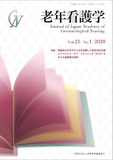Japanese
English
- 販売していません
- Abstract 文献概要
- 参考文献 Reference
抄録
本研究の目的は,血液透析時間の経過と血圧低下に伴う認知症高齢者の言動の変化と,言動から評価した苦痛の程度について明らかにしたうえで,看護実践への示唆を得ることである.対象者は血液透析を受けている認知症高齢者11人(男性2人,女性9人)である.対象者1人につき筆者ら2人が1回,入室から終了までを3分間隔で観察し30分間隔で血圧の値を収集した.苦痛の程度は,調査者作成の苦痛度基準に基づき評価し,時間経過に沿って一覧表で示した.その結果,全員に血液透析の継続に支障をきたす苦痛が1回以上出現し,4人は透析終了前1時間〜30分の間に苦痛度が高くなっていた.また10人(91%)は穿刺時に「痛い」と叫びながら,もしくは黙ってシャント肢を動かさず穿刺が終了するまで耐えていることが明らかとなった.これらの結果から看護師は,観察・ケア重点時間を設定すること,認知症高齢者の耐える力を信じ,穿刺時にいまから穿刺することを説明する必要性が示唆された.
The purpose of the study was to gain hints of nursing practice after clarifying changes of verbal behaviors of the old people with dementia influenced by duration of hemodialysis: blood-pressure lowering and degree of pain assessed from the behaviors. Participants were 11 old people with dementia (two males, nine females) receiving hemodialysis. Two researchers per one participant observed the participant once every three minutes from entering a dialysis room to the end of hemodialysis, and collected participant's blood pressure value every thirty minutes. The degree of pain was assessed on the basis of the criteria made by the researchers and shown in the list along time proceeds. All participants showed pain that disrupted the continuance of hemodialysis more than one time, and the degree of the pain in four participants became higher between thirty minutes and one hour before hemodialysis. In needle insertion, 10 participants (91%) shouted “It hurts!” or stood silent without moving their forearm (shunt side) until the end of the insertion. From these results, it is necessary for nurses to set a time to focus on observation and care, and to explain to the old people with dementia by any means necessary at the time of needle insertion while believing their patience.
Copyright © 2020, Japan Academy of Gerontological Nursing All rights reserved.


